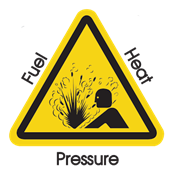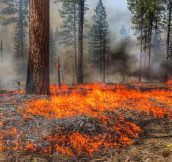

Fuel geysers continue to be reported and the potential for injury is real. In 2018, there were 28 incidents of fuel geyser reported: 23 chainsaws, a leaf blower, and four jerry cans. A fuel geyser can happen on any equipment with a fuel tank including fuel bottles and containers. Even chainsaws with two-way vents may “geyser” at high temperatures or high elevation. Users should assume all gas-powered equipment and fuel containers are pressurized.
Fuel – Know Your Fuel
- Fuel volatility changes seasonally and geographically.
- Think locally. Using fuel from a cooler climate (i.e., Idaho) in a warmer climate (i.e., Texas) increases the geysering potential.
- As elevation increases, boiling point temperatures decrease. 125oF at 8,000 feet is approximately equivalent to 140oF at 1,000 feet.
Fuel Bottles and Containers
Fuel bottles (i.e., Sigg bottles), fuel containers (i.e., dolmars or jerry cans) can geyser even after the cap is removed. To mitigate possible fuel geyser and/or potential injury from fuel bottles and cans, use the following procedures:
- Keep containers in the shade and away from any external heat source.
- Never open a fuel tank within 20 feet of any heat source.
- Gently shake the container to release surface tension. Too much agitation will create pressure.
- Open container slowly, pointing opening away and cover the opening with a cloth and glove.
Engine Powered Equipment
- Never use fuel that was stored in a fuel container for longer than one month. Older fuel may lead to poor engine performance and increased operating temperatures. Older fuel may also have higher volatility for the current conditions.
- Always check the fuel level in the tank before taking any action. Fuel levels above ½ tank are more likely to geyser.
- Never open a fuel tank within 20 feet of any heat source.
- Only after the above mitigations are completed; put the equipment in a cleared area, cover the cap with a cloth or glove, and open slowly.
For more information or if you experience a fuel geyser, see the Fuel Geyser Awareness section at
https://www.nwcg.gov/committees/equipment-technology-committee





